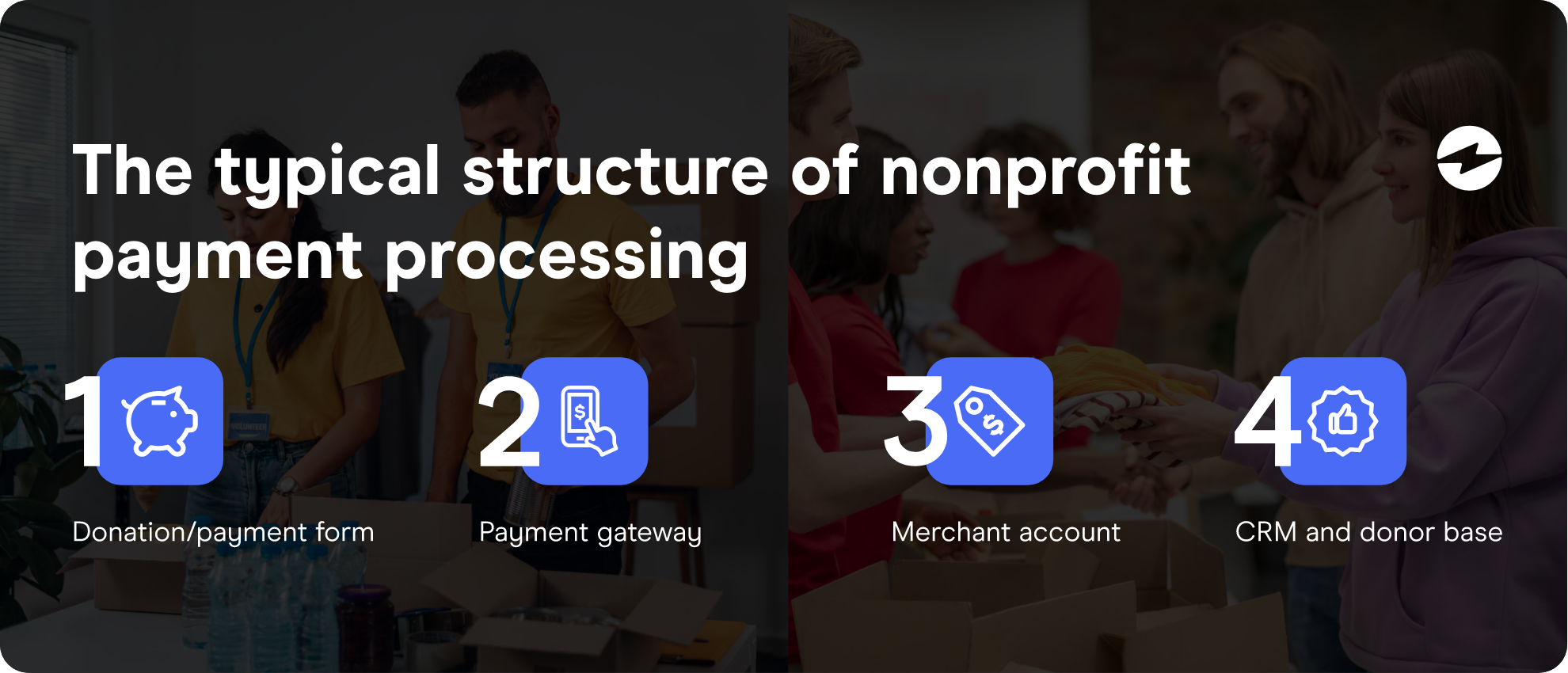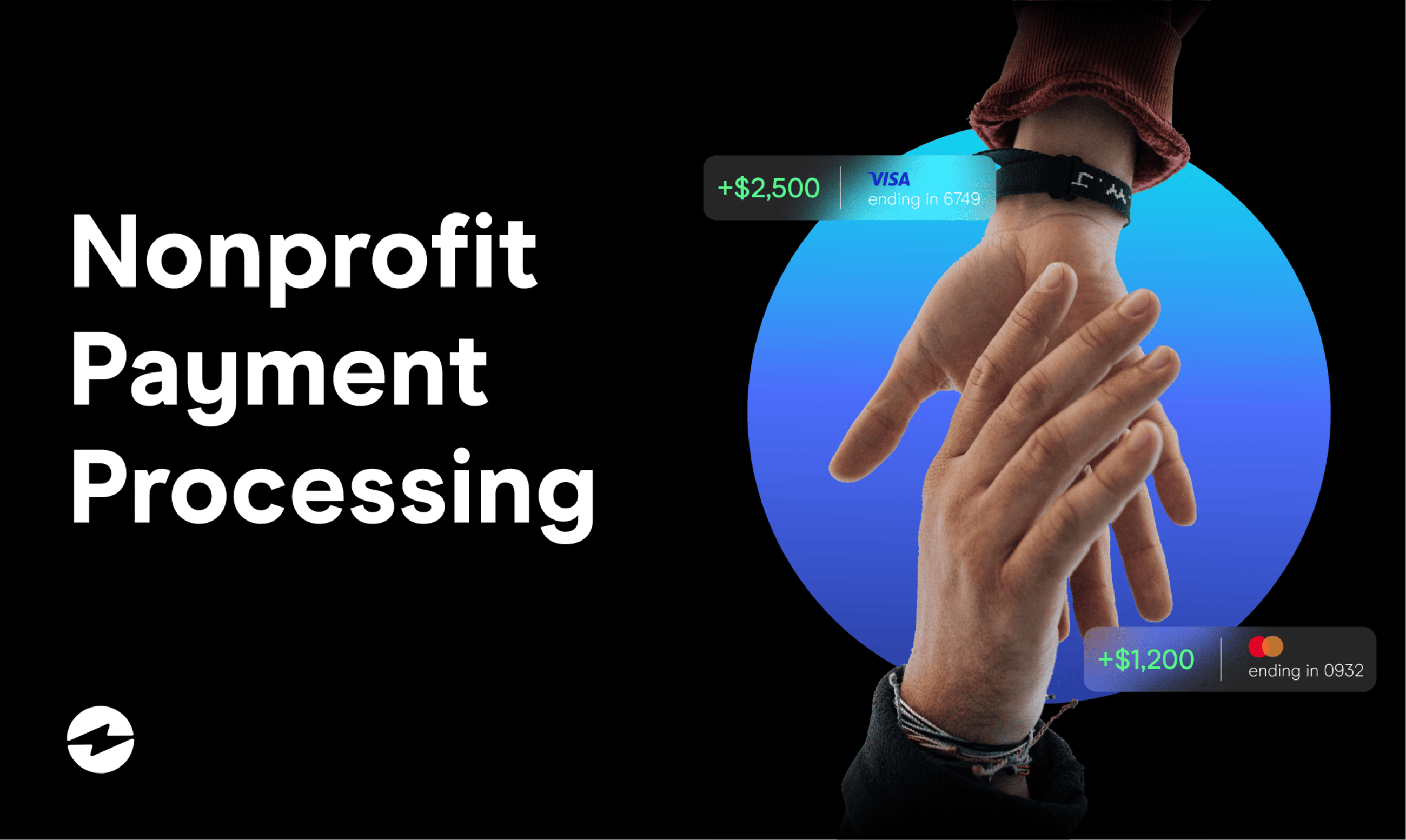Blog > Nonprofit Payment Processing
Nonprofit Payment Processing
Nonprofits rely heavily on their ability to accept donations and payments from generous donors. Therefore, credit card processing for nonprofits should be a seamless experience for all parties involved which is why it’s important to understand how this process works.
This article will break down the essentials of nonprofit credit card processing by outlining its basic components, challenges, fees, software solutions, and payment processing structure.
5 essential components of nonprofit credit card processing
Before you incorporate nonprofit donation processing into your organization, you should be aware of the required components that are essential to this process.
The 5 essential components of nonprofit credit card processing include:
- Secure online donations and payment forms
- Merchant account
- Payment gateway
- Bank account
- Secure web portal
Nonprofits have the option to acquire these components on their own or use a service that provides all the features within a single package. Before you decide how you’d like to incorporate these elements into your processing structure, you should first understand how each works.
Let’s break down each essential component…
1. Secure online donations and payment forms
Secure online donations are completed by nonprofit donors using payment forms to deposit their donations. These forms serve as an interface for donors to input their credit or debit card information to make a donation.
Payment forms are stored on a secure server that adheres to industry-mandated security protocols. These customizable forms are also used to explain how to make a donation in an easy-to-understand format to avoid any confusion on the donor’s end.
2. Merchant Account
A merchant account, not to be confused with a bank account, is a contractual arrangement between a nonprofit and a merchant acquirer. This arrangement allows the nonprofit to accept donations online via credit and debit cards and deposit the funds directly into the nonprofit’s bank account.
Merchant accounts provide detailed breakdowns of the costs included to process credit and debit cards, as well as other monthly fees associated with card processing. The merchant acquirer, which is also referred to as the acquiring bank, is the financial institution that allows the merchant to accept credit card payments.
3. Payment gateway
Simply put, a payment gateway works to sync your payment software with your merchant account and provides security and reporting tools for your business.
In some instances, payment gateways can even provide an application program interface (API) that enables nonprofits to process transactions via various interfaces such as mobile apps, light boxes, and direct software integrations.
4. Bank account
Donations and payments that are processed through online web forms or merchant accounts must be deposited into a bank account. Without a bank account, funds cannot be deposited.
That being said, a merchant account can only deposit funds to one specified bank account. Nonprofits that have their own combined merchant account and bank account can control and manage funds independently of their online web form provider. This allows payments and donations that are processed through the nonprofit’s merchant account to be fully tax-deductible, given that they’re paid directly to the nonprofit instead of through a third party.
5. Secure web portal
Secure web portals are password-protected applications that connect users to various resources all within a single, secure web space that provides resources such as virtual transaction reports that are commonly used by nonprofits.
Nonprofits using online payment processing will need to access these reports, as they outline every detail of their donations and payments and allow them to interact with this data in a hassle-free manner. Secure web portals essentially prioritize security and convenience for all users.
Receiving donations and processing payments online
To accept donations and process payments online, nonprofits often rely on online tools like secure payment forms. These virtual options provide instant, 24/7 access to payment options for donors and even allow nonprofits to expand their payment processing globally.
One of the major challenges for nonprofits is the cost to provide and maintain a secure payment processing solution.
There are many different expenses involved in creating, managing, and securing donations and payments with in-house processing solutions. Some of these expenses include server hosting, secure form creation and editing, PCI compliance, data reporting, and email transmission. Because of this, many nonprofit organizations outsource their donation and payment processing solution needs.
Nonprofit online payment processing solutions
It’s not uncommon for nonprofits to underestimate the extent of their online donation and payment needs. While many nonprofit organizations assume that using a payment processor or donation solution is simply just for fundraising and online donations, most nonprofits have dozens of transactions that could be significantly improved by using online solutions.
Other operations that are enhanced with online solutions include membership dues, gala sponsorship payments and registrations, event sign-ups, recurring donations, merchandise sales, camp registrations, and ticket sales.
There are many ways that nonprofit organizations can benefit from online solutions including the ones mentioned above. Payment processors and donation solutions make donating, as well as accepting donations, a breeze by offering secure collection tools that make the process quick and efficient.
Choosing the right donation and nonprofit payment processing solution
When it comes to looking for the best nonprofit donation processing solutions, there are plenty of options to choose from. One of the most popular payment processing options is Software as a Service (SaaS) which includes a combination of secure forms, customer relationship management (CRM), merchant accounts, and payment gateways.
SaaS is a great option for credit card processing nonprofits for a few reasons. Some of the benefits include low setup and infrastructure costs, a high level of security, and improved accessibility. With SaaS like EBizCharge, nonprofits can instantly take donations online using a wide variety of payment collection tools.
A look into the nonprofit payment processing structure
Now that we’ve broken down the basic components of nonprofit payment processing, it’s important to learn how these components work together and function within the payment processing structure.
Now that we’ve broken down the basic components of nonprofit payment processing, it’s important to learn how these components work together and function within the payment processing structure.

1. Donation/payment form
The nonprofit payment process begins when an individual enters his or her payment information into a nonprofit’s secure online form. The individual’s payment information is then verified to ensure it’s accurate and that the payment data is in a valid format.
Once the transaction has been submitted, the information is sent to and stored in the payment gateway.
2. The payment gateway
The payment gateway is one of the most important components of the online donation and payment processing structure. The payment gateway serves a few functions including storing transaction data and connecting to the merchant account processor to validate payments.
Once the payment information has been verified, the payment gateway will then determine whether to direct the transaction to the merchant account for authorization. The donor will then be notified if the transaction has been approved or denied. If the transaction is approved, the donor is sent a receipt for the transaction.
3. The merchant account
Once a transaction has been approved, the merchant account provider will begin the “settlement” process. Settlement is essentially when the transaction funds are deposited into the nonprofit’s bank account. This can take anywhere from one to five business days after authorization and can vary depending on the merchant account provider.
The merchant provider will then contact the credit card providers to ensure the donor’s payment statement is accurate.
There are fees associated with each payment, depending on the nature of the transaction. Fees imposed by a merchant account provider tend to vary depending on processing volume and the provider.
4. CRM and donor databases
Nonprofits will often use a donor database or CRM to manage and track donor transactions. CRM and donor databases offer a multitude of advantages including task automation, actionable analytics and reporting, and easy-to-acess donor information.
Businesses can transition donor data into a database using two different methods:
- Manually exporting and importing database-ready data files such as comma-separated values (CSV) files.
- Direct integration between the payment gateway and the CRM database which makes marketing and sales operations, analysis, and collaboration significantly easier by having all data accessible within a single web space.
Now that we’ve broken down the basic structure of nonprofit payment processing, let’s take a look at some of the payment processing fees that can be expected.
Typical merchant account payment processing fees
As mentioned earlier, merchant accounts typically include fees and costs for merchant services. While these fees can vary depending on the merchant account provider and processing volume, it’s important to be aware of them.
Here are the most common merchant account payment processing fees to look out for:
- Percentage transaction fees
- Per transaction flat fees
- Monthly service fees
- Statement fees
- PCI compliance fees
- Network access fees
- Chargeback fees
- Annual assessment fees
- International and business card processing fees
While fees are never fun for any business, the many benefits payment processing offers and the efficient process it provides, makes it a necessity for many nonprofits and their donors.
Nonprofits should implement the most efficient payment processing solutions and services
Nonprofit credit card processing should be an effortless process for your organization as well as its donors. Now that you understand this process and all its essential components, you can find the best solutions and services for all your payment processing needs.
Summary
- 5 essential components of nonprofit credit card processing
- Receiving donations and processing payments online
- Nonprofit online payment processing solutions
- Choosing the right donation and nonprofit payment processing solution
- A look into the nonprofit payment processing structure
- Typical merchant account payment processing fees
- Nonprofits should implement the most efficient payment processing solutions and services

